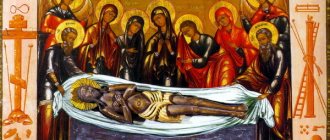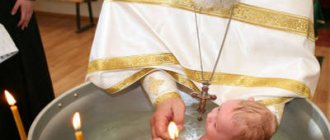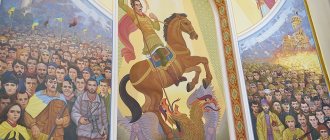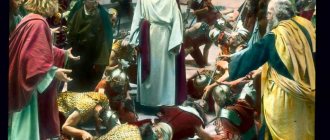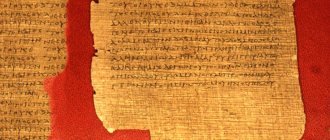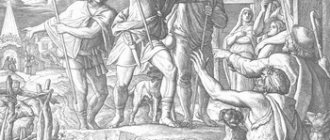Why does the Church recognize the four Gospels?
prot. Dmitry Polokhov.
The short answer is because these Gospels originated in the Church itself. The Church itself arises on the day of Pentecost - the Descent of the Holy Spirit on the Apostles (Acts 2). After which the Holy Spirit, according to the word of the Savior Himself, guided the Apostles “into all truth” (John 16:13) and reminded them of everything that the Lord had told them (see John 14:26).
At first, the Gospel was preserved and transmitted through the oral preaching of the Apostles themselves, then, as Christian communities (local Churches) grew, the need arose for a written recording of the Gospel preaching. Accordingly, the Christian communities founded by the apostles and later by the disciples of the apostles could not accept any other Gospel than the one they heard from the Apostles themselves.
Modern biblical scholarship confirms this information. For example, Bruce Metzger, a well-known specialist in the field of biblical studies and textual criticism, writes the following about the canon of the New Testament: “The Church did not create a canon, but only recognized, accepted and confirmed the self-evident value of certain documents. If we ignore this, we will come into serious conflict not with dogma, but with real history.”[1]
Gospel of Matthew
The Gospel of Matthew was compiled by one of the 12 Apostles of the Lord Jesus Christ. His other name for the Apostle Matthew is Levi Alfeev (son of Alpheus). Perhaps he was from the tribe of Levi, i.e. Instead of serving in the temple in Jerusalem, he became a publican, which was especially shameful for a Jew. Before turning to Christ, Matthew served as a publican, a tax collector for Rome. He was called by the Savior (Matt. 9.9; Mark 2:14; Luke 5:27–29) and, leaving everything, followed Him. Having received the grace-filled gifts of the Holy Spirit, the Apostle Matthew first preached in Palestine. According to legend, before leaving to preach in other countries, at the request of the Jerusalem Christian community, he compiled the Gospel in Hebrew (probably in Aramaic)[2].
According to the testimony of St. Papias, Bishop of Hierapolis of Phrygia (†155), “Matthew wrote down the conversations of Jesus in Hebrew, translated them as best he could” (see: Eusebius of Caesarea. Church History. III. 39, 16). The style of presentation of the material in the Gospel is replete with Semitism. The text was written by a person with a Jewish mentality[3]. As noted by Rev. Leonid Grilikhes, the expression “conversations (or sayings) of Jesus” (of the Lord) (Church History. III. 39, 15-16) τά λόγια – an analogue of the Hebrew “Divrei Adonai” (deeds, history of the Lord). This was the name of some sacred texts during the 2nd Temple period[4]. Regarding their translation, Father Leonid writes that here we must understand the translation and interpretation from Hebrew into army in accordance with the personal memories of the apostles (which was not a problem for Jerusalem Christians) (Ibid. P.83).
There is much evidence from church tradition regarding the adequacy of the translation of the Hebrew text of the Gospel of Matthew into ancient Greek. For example, Panten of Alexandria (†before 200) testifies that having reached the “Indian lands” with a sermon, he found there a copy of the Gospel of Matthew in Hebrew from the local Christian community, [5] which was left there by the Apostle Bartholomew (one of the 12 Apostles, martyred died in the area of modern Baku in Azerbaijan). St. Jerome of Stridon (†420) wrote that the Hebrew text of the Gospel of Matthew was kept in the Caesarea library and he saw it there.[6] (St. Jerome is a translator and knew ancient languages very well, including Hebrew, so if he had encountered a different text in the Hebrew Gospel according to Matthew, he would have definitely mentioned it). In 476 on the island. In Cyprus, during the discovery of the relics of the Apostle Barnabas (c. †62 - one of the 70 Apostles), they found the Gospel of Matthew rewritten by him; it was kept in Costantinople until 1204.[7] (Apostle Barnabas is the most likely translator of the Hebrew Gospel of Matthew into Greek).
According to Origen (†c. 254), it was the Gospel of Matthew that was written first (Eusebius Kes. Church.. Ist. VI, 25, 1). The fact that the Apostle Matthew compiled the Gospel was written in the 2nd century by the hieromartyr Irenaeus of Lyons (†202) (Against heresies. III. 1, 1). Church historian Eusebius of Caesarea also confirms this ancient tradition. (Church. Ist. VI, 24, 6).
The text itself testifies in favor of the sacred Church Tradition about the Apostle Matthew and the Gospel he compiled. For example, the inspired author of the Gospel according to Matthew is well versed in the monetary system of Palestine in the period before the destruction of the Jerusalem Temple (before 70 AD). At this time, the Jewish, Greek and Roman monetary systems were in circulation in parallel in Judea: the compiler of the text knows about this (Matt. 17:25-27; 20:2). He knows that near Capernaum there was a place where taxes were collected (Matt. 9:1, 9). He knows exactly the names of the coins that were in use in Judea and names them correctly (he mentions 10 types of coins, while Apostle Luke has 6). Focuses on questions about “taxes”, correctly names those who collected them and how much they donated for it (“collectors of didrachmas” Matthew 17:24-27; 22:19). Only a person who lived in Judea before 70 AD could know all this. (before the 1st Jewish War)[8]. These data are fully confirmed by modern archeology, i.e. It’s simply incredible to guess or fake such small details in the text.
The ancient Greek text of the first Gospel is quoted by the holy martyr Clement of Rome (†101) (disciple of the apostles Peter and Paul, see Phil. 4:3) (1 Cor. 13:2). The exact quotation from the Gospel is found in Sschmch. Ignatius the God-Bearer (†107), ep. Antioch Matthew 3:15 (Epistle to the Smirnans. 1, 1), etc.[9]. We also find quotations from this Gospel in the apologist Athenagoras of Athens (2nd century) (Cf.: Matthew 5.44-45; Luke 6.27-28 - “Intercession for Christians.” 11.2) and in the “Epistle of Barnabas” ( ca. 130): 4 ch. (Matthew 22:14), 5 ch. (Matthew 9:13), etc. A direct quotation from Matthew 28:19 about baptism “In the Name of the Father and the Son and the Holy Spirit” is in an ancient Christian written monument from the end of the 1st century. "Didahe" ("Teaching of the 12 Apostles", Syria) (Didahe. 7: 1, 3). Also in the “Didahe” is the text of the prayer “Our Father” according to Matthew 6:9-13 (Didahe. 8:2), etc. The time of writing the Gospel of Matthew: 40s. Jewish version (33-42)[10]; Greek translation – approx. '85[11] According to other researchers, the Greek translation was made by the Apostle Matthew himself and possibly before 70 [See: Karavidopoulos I. Introduction to the New Testament. M.: PSTGU, 2009. P.132-133; Knight Mc. S. Gospel of Matthew. P. 203].
Gospel of Mark
The Apostle and Evangelist Mark, although he was not one of the twelve closest disciples of Jesus Christ, was a direct witness to many events of Gospel history. His mother Mary was one of the myrrh-bearing wives. According to church tradition, the house of his mother Mary adjoined the Garden of Gethsemane. The Gospel of Mark also brings to us the personal memories of its compiler: On the night when the Savior was taken into custody in the Garden of Gethsemane, the Apostle Mark followed Him, wrapped in a veil, and ran away naked from the soldiers who grabbed him (Mark 14:51-52) . Only a direct participant could humbly write about such an inglorious episode in his life. It is known that after the Ascension of the Lord and Pentecost, the house of the mother of St. Mark became a place of prayer meetings for Christians and a refuge for some of the apostles (Acts 12:12). It was there that the Apostle Mark repeatedly heard the Gospel from Christ’s closest disciples.
In addition, Saint Mark was the closest collaborator of the apostles Peter, Paul and Barnabas. The Apostle Peter in the First Epistle calls him “Mark my son” (1 Pet. 5:13), meaning that he is his spiritual son.
The origin of the Gospel of Mark can be learned from the work “Interpretation of the Words of the Lord” (30s of the 2nd century), which belongs to the direct disciple of the apostles, Hieromartyr Papias, Bishop of Hierapolis of Phrygia. The book itself has not survived to this day, but Eusebius of Caesarea quotes it in his “Ecclesiastical History” (beginning of the 4th century): “Mark was the interpreter of Peter; He accurately wrote down everything that he remembered from what the Lord said and did, but not in order, for he himself did not hear the Lord and did not walk with Him. Later he accompanied Peter, who taught as circumstances required, and did not intend to put the words of Christ in order. Mark made no mistake in writing everything down as he remembered it; He only cared about not missing anything and not conveying it incorrectly” (Church history III. 39, 15). The text of the Gospel of Mark is characterized by Semitism of speech, the use of expressions in Aramaic, for example, “And, taking the maiden by the hand, he said to her: ‘ talifah kumi’ , which means: maiden, I say to you, stand up” (Mark 5:41) . A feature of the second Gospel is the presence of very precise topographical indications, which corresponds to the realities of Palestine[12]. This is an indirect confirmation of the historicity and reliability of the evangelist’s testimony.
Another ancient author, a disciple of the direct disciple of the apostles, Saint Polycarp of Smyrna, Hieromartyr Irenaeus, Bishop of Lyons, writes about the Gospels of Mark and Luke. In his book “Against Heresies” (80s of the 2nd century) he writes that “Peter and Paul preached the gospel in Rome and founded the Church. After their departure, Mark, the disciple and interpreter of Peter, gave us in writing what was preached by Peter. And Luke, Paul’s companion, set forth in a book the Gospel he preached” (Against Heresies. III. 1).
The Holy Martyr Justin Philosopher (second half of the 2nd century), in his essay “Dialogue with Tryphon the Jew,” citing a quotation from Mark 3:17, says that it is contained in the work entitled “Memoirs of Peter” (“Dialogue with Tryphon the Jew”). a Jew")[13]. The ancient document Canon Muratori (2nd half of the 2nd century) tells us the same thing[14]. Clement of Alexandria (†c. 215) also mentions the Gospel of Mark (see Eusebius Kes. Church. Ist. VI. 14, 5-7.)[15]. Quotations from the Gospel of Mark are in the Epistle of Barnabas, chapter 5. (Mark 2:17); Chapter 11 (Mark 7:4). The Gospel of Mark is known to the author of the ancient Christian work “The Shepherd” Hermas (late 1st century - early 2nd century) Mark 4:3-8 (Shepherd III 9. 13) and Mark 10:15 (Shepherd III 9, 29). Because 93% of the material in the Gospel of Mark is found in Matthew and Luke, then quotations from parallel passages in the Gospel of Matthew and Luke by ancient authors can also be attributed to the text of the Gospel of Mark.
In other words, the Gospel of Mark is actually the Gospel sermon of the Apostle Peter, i.e. The Gospel of Peter[16]. As for the time of compilation of the Gospel, most modern biblical scholars place it before 70 AD. (before the destruction of Jerusalem)[17]. Some scholars, after Jose O'Callaghan identified a fragment of papyrus Q5 from Qumran 7 with a small fragment from the Gospel of Mark in 1972 (see: Mark 6, 52–53 = 7Q5), believe that the Gospel of Mark “was written even before 50 AD.”[18].
Gospel of Luke
Like Saint Mark, the Evangelist Luke was one of the 70 Apostles and during his lifetime witnessed the preaching and miracles of the Savior. According to legend, the evangelist Luke was sent by the Lord to preach the first sermon about the Kingdom of Heaven among the other 70 disciples (Luke 10:1-3). He also witnessed, together with Cleopas, the appearance of the Risen Lord on the road to Emmaus (Luke 24:13-35).
Saint Luke was the interlocutor of the Most Holy Theotokos, as evidenced by the text of the Gospel compiled by him under the inspiration of the grace of the Holy Spirit. The Gospel of Luke contains memories of the events preceding the Nativity of John the Baptist and the Nativity of Christ, memories of the Mother of God about the childhood of Jesus Christ (Luke 1 and 2 chapters). From the first verses of the Gospel of Luke it is clear that the apostle communicated with many witnesses to the earthly life of the Lord Jesus Christ, knew and used the texts of the Gospel of Mark and Matthew when compiling the Gospel. For example, about 91% of the information in the Gospel of Mark is contained in the Gospel of Luke.[19] The Apostle Luke witnessed the life of the early Christian community in Jerusalem, which he writes about in the book of the Acts of the Apostles. He was also an assistant and companion of the Holy Apostle Paul (Col.4:14, Phil.1:24, 2Tim.4:10). Indirect confirmation of the church tradition that the compiler of the third Gospel is the “beloved physician” Luke (Col. 4:14) is evidenced by the author’s knowledge of the professional medical terminology of that time[20].
Hieromartyr Ignatius the God-Bearer knows the words from the Gospel of Luke: “When He (Jesus) appeared to them with Peter, He said to them: “Touch Me and handle Me, and you will see that I am not an incorporeal ghost”” (Epistle to Humility 3 1-2; cf. Luke 24:39). In addition to the mentioned hieromartyr Irenaeus of Lyons, Clement of Alexandria writes about the Gospel of Luke as a text recognized by all Christians (see Eusebius Kes. Church. Ist. VI.14:5)[21]. This Gospel is quoted by the Hieromartyr Clement of Rome (c. 95) (1 Cor. 13:2; 48:4), a direct disciple of the Apostle Peter, who heard him preach about Christ. The apologist Athenagoras of Athens (2nd century) has references to the Gospel of Luke (Luke 6:27-28 - “Petition for Christians.” 11.2). Gnostic heretic Marcion ca. 160 is well acquainted with the text of the third Gospel (see: “Instrumentum”).
Hieromartyr Hippolytus of Rome at the beginning of the 3rd century calls the Apostle Luke an evangelist. (About Christ and Antichrist. 56). Eusebius of Caesarea (Church. Ist. III. 4, 6-7) and many other ancient Christian authors write about the Apostle Luke as the compiler of the third Gospel.
The Gospel of Luke is dated by modern scholars to the time before 63 [Stanislav (Gondetsky), bishop. Introduction to the Synoptic Gospels. P. 102.]
Gospel of John
The Gospel was compiled by the Lord’s closest and beloved disciple, the Apostle and Evangelist John the Theologian. He was the son of Zebedee and Salome, daughter of Saint Joseph the Betrothed. At the same time as his older brother James, he was called by Jesus Christ to be one of His 12 disciples on Lake Gennesaret. Leaving their father, both brothers followed the Lord. (John 1:35-37; Matt. 4: 21-22; Mark 1:19-20).
Characteristic of the compiler of the fourth Gospel is an accurate knowledge of the topography of Jerusalem before 70 AD. The author knows the exact location of Bethesda - John 5:2 (discovered at the end of the 19th century, studied in detail by archaeologists in the 60s of the 20th century). The pool of Siloam is mentioned – John 9:7. The text distinguishes Bethany near the Jordan from Bethany near Jerusalem - John 1:28, 11:18 and many more. etc. The text uses Aramaic words, for example, “in a place called Liphostroton, and in Hebrew Gavvatha ” (John 19:13); “said to Him: Rabbi! - which means: Teacher! (John 20:16)[22]. In some places, the form of presentation of the text is close to the literature of Qumran and early rabbinic literature[23]. All this only confirms the antiquity of the text and the Palestinian context of the Gospel of John[24].
Many ancient Christian writers testify to the inspired authorship of the Apostle John the Theologian. Indirect testimony of Papias of Jerusalem (Eusebius Kes. Church. Ist. III. 39, 3). St. Irenaeus of Lyons clearly speaks of the Apostle John the Theologian as the compiler of the Fourth Gospel (Against heresy III, 1, 1; III, 2, 9.11). According to the testimony of church authors (Clement of Alexandria and others), the Evangelist John, already in his old age (in the city of Ephesus), testified to the truth of all 3 Gospels (Matthew, Mark and Luke), which were brought to him from different places and in addition to he compiled the fourth Gospel (Eusebius Kes. Church. Ist. III. 24, 7. VI. 14, 7). Bishop Polycrates of Ephesus writes around 190 that the most faithful witnesses of church orthodoxy confirm that the Gospel was compiled by John the Theologian (Church. Ist. III. 23, 2.).
Hieromartyr Ignatius the God-Bearer has many parallels with the Gospel of John. In the Epistle to the Magnesians he speaks of God: “He showed Himself through His Son, Jesus Christ, who is His Word spoken out of silence, who in all things found favor with Him who sent Him” (Ep. ad Magn. 8; cf. John 1 1 and 8. 28-29). Athenagoras of Athens (c. 177) quotes from the fourth Gospel: “The Son of God is the Word of the Father, as His idea and as active power, for by Him and through Him all things were created, because the Father and the Son are one” (Cf. John 1:1-3; 10:30; 17:3). (Petition for Christians. 10). Knows the Gospel of St. Irenaeus of Lyons (Against heresies III 8.2), Tertullian († after 220) (Against Praxeus. Ch. 2) and many others. etc.
The time when the Gospel of John was written, according to modern biblical studies, is 90-100. [see: Thompson MM Gospel of John // Jesus and the Gospels. Dictionary. P.168].
In the ancient Christian work “The Shepherd” of Hermas (late 1st - 1st half of the 2nd century) one can find allusions to all 4 canonical Gospels. Thus, it is said that only those who have received the name of the Son of God enter the Kingdom of God (Shepherd III 9.13; cf. John 3.15-18), in the interpretation of the parable of the sower (Matt 13.3-8; Mark 4.3-8; Luke 8.5-8) the author notes: “It will be difficult for such people (vain) to enter the Kingdom of God” (Shepherd III 9.13; cf. Matthew 19.23), but those who are like children, “will undoubtedly be found in the Kingdom of God” (Shepherd III 9.29; cf. Mk 10.15; Lk 18.17)[25].
All four Gospels, and no more, were brought together into one agreement by Tatian the Assyrian, the text known as the Diatessaron (“through four”) c. 170 (probably in Aramaic). He had the circulation of the Church (in the East, especially in Syria) until the 5th century.
The presence of ancient papyri with the text of the canonical Gospels confirms their prevalence and authority from the end of the 1st to the 2nd centuries. AD (For example, you can take the so-called Ryland papyrus p52 (120-150); papyrus “Bodmer II” (p66) (almost the entire Gospel of John). This manuscript with partially missing leaves dates back to approximately the end of the 2nd century ( ca. 200 A.D.) Here we should also add K. Thied’s re-dating of papyrus p64 (Gr17) with a fragment of the Gospel of Matthew, Chapter 26 in ancient Greek from 200 to 64-69).
In the early Christian monument “Didahe” (late 1st century), the use of the word Gospel (εὐαγγέλιον) is an already established and well-defined tradition to which the author refers (Didahe. 15. 3-4). Even enemies and critics of Christianity, such as the pagan philosopher Celsus (mid-2nd century), in their writings quote texts from the four canonical Gospels.[26] Therefore, an unprejudiced and thinking person cannot remain in any doubt about the truth of the Four Gospels.
PS Evidence from the Bible. The most ancient manuscripts of the Gospel that have come down to us
See on our website : Craig Blomberg. Historical reliability of the Gospels.
Notes:
[1] Metzger B.M. Canon of the New Testament. Emergence, development, significance. M.: BBI, 2011. pp. 280-281.
[2] Some researchers believe that the text was written in biblical Hebrew (see Carmignac J. The Birth of the Synoptic Gospels. M., 2005. P. 14; Griliches L., priest. Archeology of the text. Comparative analysis of the Gospels of Matthew and Mark in the light of Semitic reconstruction. M., 1999. P.81.). Other authors believe that the text was first written in Palestinian Aramaic (see: Donald Guthrie and others, see L. Griliches, priest. Archeology of the text. P. 81; 15).
[3] Stanislav (Gondetsky), bishop. Introduction to the Synoptic Gospels. M., 2004. P. 47, 53. In the Gospel of Matthew. More than 60 references to the Old Testament, and in most cases the quotations are given not from the LXX translation, but from the Hebrew original. (See: Grilikhes L., priest. Archeology of the text. Comparative analysis of the Gospels of Matthew and Mark in the light of Semitic reconstruction. P. 61.)
[4] Griliches L., priest. Archeology of the text. P.84-85.
[5] Perhaps we are talking not so much about India as about South Arabia or Ethiopia, where, according to legend, the Apostle and Evangelist Matthew preached. (https://mystudies.narod.ru/name/p/pantaenus.htm).
[6] Jerome of Stridon, blessed. About famous men, 3.
[7] The historicity of Jesus Christ // https://1damer.livejournal.com/133857.html
[8] See: Stanislav (Gondetsky), bishop. Introduction to the Synoptic Gospels. M., 2004. P.45-46.
[9] Compare: Matthew 5.7; 6. 14-15; 7. 1-2, 12; Luke 6.31, 36-38
[10] See: J. Carmignac. The Birth of the Synoptic Gospels. P. 83.
[11] See: Knight Mc. S. Gospel of Matthew // Jesus and the Gospels. Dictionary. M.: BBI, 2003. P. 203.
[12] See: Stanislav (Gondetsky), bishop. Introduction to the Synoptic Gospels. P.25-26.
[13] Justin the Philosopher, martyr. Creations. M.: “Pilgrim”, 1995. P. 304.
[14] The Muratori Canon reports that the Apostle Mark listened to Peter's sermons and wrote them down. (See: Stanislav (Gondetsky), bishop. Introduction to the Synoptic Gospels. M., 2004. P. 19).
[15] From the unfinished “Essays” (Ὑποτυπώσεις) of Clement of Alexandria, which Eusebius of Caesarea quotes: “The Gospel of Mark arose under such circumstances: Peter, being in Rome and preaching the teaching of Christ, expounded, filled with the Spirit, what is contained in the Gospel. Those who listened - and there were many of them - convinced Mark, as Peter’s longtime companion, who remembered everything he said, to write down his words. Mark did so and gave this Gospel to those who asked. Peter, having learned about this, did not forbid Mark, but did not encourage him either.”
[16] Prot. Leonid Grilikhes convincingly proves that the Gospel of Mark is a record of the sermon of the Apostle Peter, who preached with the Hebrew text of the Gospel of Matthew in front of him. Those. The Apostle Mark translated the speech of the Apostle Peter from Aramaic into Greek during his sermons in Antioch and Rome. (Griliches L., priest. Archeology of the text. P. 77).
[17] See: Evans Craig. Jesus through the eyes of scientists: The truth and lies of the latest discoveries and scandalous studies. M.: Eksmo, 2011. P. 65.
[18] Stanislav (Gondetsky), bishop. Introduction to the Synoptic Gospels. P. 22.
[19] See: Jesus and the Gospels: a dictionary. M.: BBI, 2003. P. 220.
[20] He distinguishes “high fever” from “weak” (Luke 4:38); uses the professional word “paralytic” Luke 5:18 and many more. etc. See: Stanislav (Gondetsky), bishop. Introduction to the Synoptic Gospels. P.94-95.
[21] In the “Essays” that have not reached us. About the 4 canonical Gospels - Clem. Alex. Strom. III 13. 93. 1.
[22] See Griliches L., priest. Archeology of the text. P.14.
[23] See: Stanislav (Gondetsky), bishop. John's writings. M., 2005. P.26-27.
[24] The Gospel of John is not influenced by Greek philosophy, in particular the doctrine of the Logos. Philo of Alexandria and the Apostle John the Theologian rely on the Old Testament, where there are the origins of the doctrine of the Logos, which they understand differently. (see: Stanislav (Gondetsky), Bishop of the Scriptures of John. M., 2005. pp. 25-26). The concept of the "Word of God" as "Memra" - one of the forms of Epiphany, is used in the targums as an analogue of the Greek "Logos" more than 600 times and has been interpreted as a reference to the Messiah. Later, in the Talmud, under the influence of polemics with Christians, it disappears. (See Santala R. Messiah in the New Testament. In the light of rabbinic writings. St. Petersburg: Bible for everyone, 1996. P. 162).
[25] Gospel. Part 1. / Orthodox Encyclopedia /
[26] See: Four Gospels. Interpretation and guide to study. Comp. M. Barsov.
New Testament. Four Gospels. Lecture 1
Brief lecture notes
What are the similarities and differences in the Four Gospels?
The difference is that it was written by different authors and each of them presented the events in their own way. We know the Gospel from Matthew, from Mark, from Luke, from John. They were all Apostles and wrote about the same events taking place and it turned out as if it was one book. The entire Four Gospels are permeated by one idea - this is the idea of saving humanity by God himself, incarnate in the form of his son Jesus Christ.
We have Divine revelation
- this is what was revealed about God by God himself, this is God’s message about himself. We can learn about him in Holy Scripture and Holy Tradition.
Holy Scripture is the material form of revelation
. Sacred Tradition is also recorded, but for the most part it is the experience of transmitting the truths revealed by God, the experience of the Holy Fathers about this truth, about the spiritual life they experienced, which they themselves recorded in their creations; these are also the writings of their successors and disciples.
Bible
(from Greek -
book, collection of books
) - was formed from the 13th century BC to the 3rd century AD, approximately
10-12 centuries
. The Bible is divided into the Old Testament and the New Testament.
Old Testament
- this is the first part of the Bible and books belonging to the first prophet Moses.
The Old Testament includes 5 books
: Genesis, Exodus, Leviticus, Numbers and Deuteronomy.
In the Russian Bible in the Old Testament, a division arose into legal
,
historical
,
teaching
, and
prophetic
parts. In Hebrew there are three: Law, Prophets and Scriptures.
The entire Bible and Old Testament aimed at one thing - the New Testament.
The second part of the Bible is the New Testament
. It was formed from the 1st to the 5th century after the Nativity of Christ. The New Testament is divided into the Four Gospels, the Book of Acts of the Holy Apostles, the Council Epistles, the Epistles of Paul, and the Apocalypse. The Four Gospels are a single body with one difference - the authors: Matthew, Mark, Luke, John. It is the basis of the Bible. The Book of Acts of the Holy Apostles is a story about the deeds of the Apostles, mainly Paul. The conciliar messages are addressed to the entire church. Apocalypse is the latest book and the most controversial in content.
The entire history of the formation of the New Testament was a struggle for the purity of the canon. During its formation, many people from various pagan religions came to Christianity. There were people close to the church who tried to rewrite and interpret the Divine Revelation and the personality of Jesus Christ to suit their understanding and worldview. They wanted to transfer their baggage of the past into the books of the New Testament, while signing themselves with significant and authoritative personalities (for example, Mary Magdalene, Judas). And therefore the Apocalyptic Gospel is very difficult to understand: where is real and where is not.
It was very difficult for faithful Christians to navigate this stream of literature, which could be used to guide their lives and build a pure worldview. Therefore, the Holy Fathers formed a list of accurate canonical books, they discarded dubious writings and left only the four Gospels.
The Four Gospels are written in Greek. The Lord spoke in Hebrew and, in the style of the traditions of that century, spoke sermons in poetic form (parables), which we see in Scripture.
Visual materials:
The lecture notes were compiled by course attendee
Inna Shervinskaya
Gospel of Mark. Chapter 4
To main
All authors
Home → Bible → Gospel of Mark
1 And he began to teach again by the sea; and a great crowd gathered to Him, so that He entered into a boat and sat on the sea, and all the people were on the land by the sea.[1] Mf. 13:1. OK. 8:4.
2 And he taught them in many parables, and in his teaching he said to them: 3 Listen: behold, a sower has gone out to sow; 4 And as he sowed, it happened that some fell by the wayside, and birds came and devoured them.
5 Others fell on a rocky place,
where there was little earth, and it soon sprang up, because the earth was shallow; 6 When the sun rose, it withered and, as if it had no root, withered away.
7 Some fell among the thorns, and the thorns grew and choked the seed,
and it did not bear fruit.
8 And some fell on the good ground and produced fruit, which sprang up and grew, and brought forth some thirty, some sixty, and some a hundred.
9 And he said to them: He who has ears to hear, let him hear!
10 When he was left without people, those around Him, together with the twelve, asked Him about the parable.
11 And he said to them, “To you it has been given to know the secrets of the kingdom of God, but to those outside everything happens in parables.”[11] Matt. 11:25; 16:17. 1 Cor. 2:10. 12 so that they look with their own eyes and do not see; they hear with their ears and do not understand, lest they convert, and their sins be forgiven.[12] Is. 6:9-10. Mf. 13:14. OK. 8:10. In. 12:40.
13 And he said to them: Do you not understand this parable? How can you understand all the parables?
14 The sower sows the word.[14] Mf. 13:18. OK. 8:11.
15 Sown
by the way means those in whom the word is sown, but
to whom,
when they hear, Satan immediately comes and snatches away the word sown in their hearts.
16 In the same way, what was sown on rocky ground
signifies those who, when they hear the word, immediately receive it with joy,[16] Isa. 42:20. Ezek. 33:31. In. 5:35. 17 But they have no root in themselves and are unstable; then, when tribulation or persecution comes because of the word, they are immediately offended.
18 Those sown among thorns are those who hear the word, 19 but in whom the cares of this world, the deceitfulness of riches, and other desires enter into them and choke the word, and it becomes unfruitful.[19] OK. 12:15. 1 Tim. 6:9.
20 And what was sown on good ground means those who hear the word and receive it, and bear fruit, some thirtyfold, some sixtyfold, some a hundredfold.
21 And he said to them, “Is a candle brought for this purpose, to put it under a bushel or under a bed?” is it not to place it on a candlestick?[21] Matt. 5:15. OK. 8:16.
22 There is nothing hidden that will not come to light, and nothing hidden that will not come out.[22] Mf. 10:26. OK. 8:17; 12:2.
23 If anyone has ears to hear, let him hear!
24 And he said to them, Take note of what you hear: with the measure you use, it will be measured back to you, and more will be added to you who hear.[24] Mf. 7:2. OK. 6:38.
25 For whoever has, to him will be given, but whoever does not have, even what he has will be taken away from him.[25] Mf. 13:12; 25:29. OK. 8:18; 19:26.
26 And he said: The kingdom of God is as if a man casts seed into the ground, 27 and sleeps and rises night and day; and how the seed sprouts and grows, he does not know, 28 for the earth itself produces first greenery, then an ear, then a full grain in the ear.
29 When the fruit is ripe, he immediately uses the sickle, because the harvest has come.
30 And he said: What shall we compare the kingdom of God to? or by what parable shall we portray it?[30] Matt. 13:31. OK. 13:18.
31 It is like a mustard seed, which, when sown in the ground, is the smallest of all the seeds on earth; 32 And when it is sown, it comes up and becomes larger than all the grains, and puts out large branches, so that the birds of the air can take refuge under its shade.
33 And with many such parables he preached the word to them as far as they could hear.[33] Mf. 13:34.
34 But he did not speak to them without a parable, but explained everything to his disciples in private.
35 In the evening of that day he said to them, “Let us cross over to the other side.”[35] Mf. 8:23. OK. 8:22.
36 And they sent the people away, and took Him with them, as He was in the boat; There were other boats with Him.
37 And a great storm arose; the waves beat on the boat, so that it was already filling with water.
38 And He slept on the stern at the head. They wake him up and say to him: Teacher! Do You really not need that we perish?
39 And standing up, He rebuked the wind and said to the sea: Be still, cease. And the wind died down, and there was great silence.[39] Job. 26:12. Ps. 88:10.
40 And he said to them: Why are you so fearful? How do you have no faith?
41 And they feared with great fear, and said among themselves, Who is this, that even the wind and the sea obey him?
Next page →
← 3 pages. Gospel of Mark
5 pages → Pages:
4
Total 16 pages
© "Online-Chit.RF" Feedback
Author of the Fourth Gospel
⇐ PreviousPage 3 of 51Next ⇒
We see that the author of the fourth Gospel set out to show the Christian faith in such a way that it would become attractive to the Greeks, who had already reached the message about Jesus, and, at the same time, to oppose heresies and errors that arose within the Church. We keep asking ourselves: who was its author? Traditions unanimously say that the author was the Apostle John. We will see that beyond any doubt the authority of John really stands behind this Gospel, although it is quite possible that he did not write it down and give it its form. Let's collect everything we know about John.
He was the youngest of the sons of Zebedee, who had a fishing boat on the Sea of Galilee and was rich enough to hire hired laborers (Mark 1:19-20).
John's mother was named Salome and it is quite possible that she was the sister of Mary, the Mother of Jesus
(Matt. 27:56; Mark 16:1).
John, together with his brother James, followed Jesus at the call of Jesus
(Mark 1:20).
It seems that James and John were fishing with Peter (Luke 5:7-10). AND
John belonged to the closest disciples of Jesus, because the list of disciples always begins with the names of Peter, James and John, and at some great events only these three were present
(Mark 3:17; 5:37; 9:2; 14:33).
By character, John was quite obviously a restless and ambitious man. Jesus gave John and his brother the name Boanerges,
What does
sons of thunder mean?
John and his brother James were impatient and opposed any self-will on the part of others
(Mark 9:38; Luke 9:49).
Their temperament was so unbridled that they were ready to wipe out a Samaritan village because they were not treated with hospitality while they were on their way to Jerusalem
(Luke 9:54).
Either they themselves, or their mother Salome, cherished ambitious plans.
They asked Jesus that when He received His Kingdom, He would seat them on the right and on the left in His glory (Mark 10:35; Matt 20:20).
In the Synoptic Gospels, John is presented as the leader of all the disciples, a member of Jesus' intimate circle, and yet extremely ambitious and impatient.
In the book of Acts of the Holy Apostles, John always speaks with Peter, but does not speak himself. His name is among the first three in the list of apostles (Acts 1:13).
John was with Peter when they healed the lame man near the Red Gate of the Temple
(Acts 3:1 et seq.).
Together with Peter, he was brought and placed before the Sanhedrin and the leaders of the Jews;
At the trial, both behaved amazingly boldly (Acts 4:1-13).
John went with Peter to Samaria to check what Philip had done there
(Acts 8:14).
In Paul's letters the name John is mentioned only once. In Gal. 2.9
he is called a pillar of the Church along with Peter and James, who approved of Paul's actions. John was a complex man: on the one hand, he was one of the leaders among the apostles, a member of the intimate circle of Jesus - His closest friends; on the other hand, he was a willful, ambitious, impatient and at the same time courageous man.
We can look at what was told about John in the era of the young Church. Eusebius says that he was exiled to the island of Patmos during the reign of the Roman emperor Domitian (Eusebius, History of the Church, 3.23). There Eusebius tells a characteristic story about John, borrowed from Clement of Alexandria. He became a kind of bishop of Asia Minor and once visited one of the church communities near Ephesus. Among the parishioners he noticed a slender and very handsome young man. John turned to the elder of the community and said: “I hand over this young man to your responsibility and care, and I call the parishioners to witness this.”
The presbyter took the young man into his home, cared for him and instructed him, and the day came when the young man was baptized and accepted into the community. But soon after that, he made friends with bad friends and committed so many crimes that he eventually became the leader of a gang of murderers and thieves. When John visited this community again some time later, he turned to the elder: “Restore the trust that I and the Lord have placed in you and the church you lead.” At first the presbyter did not understand at all what John was talking about. “I mean that you give an account of the soul of the young man whom I have entrusted to you,” said John. “Alas,” answered the presbyter, “he died.” “Dead?” - asked John. “He is lost to God,” answered the presbyter, “he fell from grace and was forced to flee the city for his crimes, and now he is a robber in the mountains.” And John went straight to the mountains, deliberately allowing himself to be captured by bandits, who led him to the young man, who was now the leader of the gang. Tormented by shame, the young man tried to run away from him, but John ran after him. "My son! - he shouted, - You are running from your father. I am weak and old, have pity on me, my son; Do not be afraid, there is still hope for your salvation. I will defend you before the Lord Jesus Christ. If necessary, I will gladly die for you, as He died for me. Stop, wait, believe! It was Christ who sent me to you.” Such a call broke the young man’s heart; he stopped, threw away his weapon and began to sob. Together with John, he descended from the mountain and returned to the Church and the Christian path. Here we see John's love and courage.
Eusebius (3,28)
tells another story about John, which he found in Irenaeus (140-202), a student of Polycarp of Smyrna. As we have already noted, Cerinthius was one of the leading Gnostics. “The Apostle John once came to the bathhouse, but when he learned that Cerinthius was there, he jumped up from his place and rushed out, because he could not stay under the same roof with him, and advised his companions to do the same. “Let’s leave so that the bathhouse doesn’t collapse,” he said, “because Cerinthius, the enemy of truth, is inside there.” Here is another touch on John's temperament: Boanerges has not yet died in him.
John Cassian (360-430), who made a significant contribution to the development of the doctrine of grace and to the development of Western European monasticism, gives another story about John. One day he was found playing with a tamed partridge. The more severe brother reproached him for wasting his time, to which John replied: “If the bow is always kept drawn, it will soon cease to shoot straight.”
Jerome of Dalmatia (330-419) has a story about the last words of John. When he was dying, his disciples asked him what his last words would be to them. “My children,” he said, “love one another,” and then he repeated it again. "And it's all?" asked him. “This is sufficient,” said John, “for this is the covenant of the Lord.”
Favorite student
If we have carefully followed what has been said here about the Apostle John, we should have noticed one thing: we took all our information from the first three Gospels. It is surprising that the name of the Apostle John is never mentioned in the fourth Gospel. But two other people are mentioned.
First, it talks about the disciple whom Jesus loved.
He is mentioned four times.
He reclined at the breast of Jesus during the Last Supper (John 13:23-25);
Jesus left His Mother in his care when he died on the cross
(19:25-27);
he and Peter were greeted by Mary Magdalene upon their return from the empty tomb on the first morning of Easter
(20:2),
and he was present at the final appearance of the risen Jesus to his disciples on the shores of the Sea of Tiberias
(21:20).
Secondly, in the fourth Gospel there is a character whom we would call a witness, an eyewitness.
When the fourth Gospel tells of how a soldier struck Jesus in the side with a spear, after which blood and water immediately flowed out, it is followed by the comment: “And he who saw it bore witness, and his testimony is true;
he knows that he speaks the truth, so that you may believe” (19:35).
At the end of the Gospel it is again said that this beloved disciple bears witness to all this, “and we know that his testimony is true”
(21:24).
Here we have a rather strange thing. In the fourth Gospel, John is never mentioned, but the beloved disciple is mentioned, and, in addition, there is a special witness, an eyewitness to the whole story. According to tradition, there was never any doubt that the beloved disciple was John. Only a few tried to see Lazarus in him, for it is said that Jesus loved Lazarus (John 11:3.5),
or the rich young man, of whom it is said that Jesus, looking at him, loved him
(Mark 10:21).
But although the Gospel never speaks of this in such detail, according to tradition the beloved disciple has always been identified with John and there is no need to question this.
But one very real problem arises - assuming that John actually wrote the Gospels himself, would he really talk about himself as the disciple whom Jesus loved? Would he want to distinguish himself in this way and, as it were, declare: “I was His favorite, He loved me most of all?” It may seem unlikely that John would have given himself such a title. If it is given by others, it is a very pleasant title, but if a person assigns it to himself, it borders on almost incredible vanity.
Maybe then this Gospel was the testimony of John, but was written down by someone else?
Product of the church
In our search for truth, we began by noting the outstanding and exceptional points of the fourth gospel. The most notable aspect is the long speeches of Jesus, sometimes taking up entire chapters, and are completely different from how Jesus is presented with his speeches in the other three Gospels. The Fourth Gospel was written around the year 100, that is, approximately seventy years after the crucifixion of Christ. Can what was written seventy years later be considered a literal rendering of what Jesus said? Or is it a retelling of them with the addition of what has become clearer over time? Let's remember this and take into account the following.
Among the works of the young Church, a whole series of reports has come down to us, and some of them relate to the writing of the fourth Gospel. The most ancient of them belongs to Irenaeus, who was a student of Polycarp of Smyrna, who, in turn, was a student of John. Thus, there was a direct connection between Irenaeus and John. Irenaeus writes: “John, the disciple of the Lord, who also leaned on His chest, himself published
The Gospel in Ephesus while he lived in Asia."
The word in this phrase of Irenaeus suggests that John did not just write
Gospel;
he says that John published (Exedoke)
it in Ephesus. The word that Irenaeus used suggests that this was not just a private publication, but the promulgation of some kind of official document.
Another account comes from Clement of Alexandria, who in 230 was the head of the great theological school in Alexandria. He wrote: “The very last John, having seen that everything connected with the material and corporeal, was properly reflected in the Gospels, prompted by his friends,
wrote a spiritual gospel."
being prompted by one's friends is of great importance here
It becomes clear that the fourth Gospel is more than the personal work of one person, and that behind it stands a group, a community, a church. In the same spirit we read of the fourth Gospel in a tenth-century copy called the Codex Toletanus, in which each of the books of the New Testament is prefaced by a short summary. Concerning the fourth Gospel it says the following:
“The Apostle John, whom the Lord Jesus loved most, was the last to write his Gospel at the request of the bishops of Assia
against Cerinthius and other heretics."
Here again is the idea that behind the fourth Gospel is the authority of the group and the Church.
Now let us turn to a very important document known as the Muratorian Canon - it is named after the scientist Muratori who discovered it. This is the first list of books of the New Testament ever published by the Church, compiled in Rome in the year 170. It not only lists the books of the New Testament, but gives short accounts of the origin, nature and content of each of them. Of great interest is the account of how the fourth Gospel was written: “At the request of his fellow disciples and his bishops, John, one of the disciples, said: “Fast with me three days from this, and whatever may be revealed to each of us, whether in favor of my Gospel or not, let us tell it to each other.” That same night it was revealed to Andrei that John must tell everything, and everyone else should help him, who then check everything that is written.”
We cannot agree that the Apostle Andrew was in Ephesus in the year 100 (apparently it was another disciple), but it is quite clear here that although the fourth Gospel stands behind the authority, intelligence and memory of the Apostle John, it is the work of not one person, but a group.
Now we can try to imagine what happened. Around the year 100, there was a group of people in Ephesus around the Apostle John. These people revered John as a saint and loved him like a father: he must have been about a hundred years old at that time. They wisely reasoned that it would be very good if the aged apostle wrote down his memories of those years when he was with Jesus.
But in the end they did a lot more. We can imagine them sitting and reliving the past. They must have said to each other, “Remember when Jesus said...?” And John must have responded, “Yes, and now we understand what Jesus meant by this...” In other words, these people not only wrote down what he said
Jesus - it would only be a victory of memory, they wrote down what Jesus
meant by it.
They were guided in this by the Holy Spirit Himself. John thought through every word Jesus once said, and he did it under the guiding guidance of the Holy Spirit, so real in him.
There is one sermon entitled “What Jesus Becomes to the Man Who Knows Him Long.” This title is an excellent definition of Jesus as we know Him from the Fourth Gospel. All this was excellently outlined by the English theologian A. G. N. Green-Armitage in the book “John Who Saw It.” The Gospel of Mark, he says, with its clear presentation of the facts of the life of Jesus, is very convenient for the missionary;
The Gospel of Matthew, with its systematic presentation of the teachings of Jesus, is very convenient for
a teacher;
The Gospel of Luke, with its deep sympathy for the image of Jesus as the friend of all men, is very convenient for
the parish priest or preacher,
and the Gospel of John is the Gospel for
the contemplative mind.
Greene-Armitage goes on to say that there is an obvious difference between the Gospels of Mark and John: “Both of these Gospels are in some sense the same. But where Mark sees things flatly, directly, literally, John sees them subtly, soulfully, spiritually. You could say that John illuminates the lines of the Gospel of Mark with a lamp.”
This is an excellent characteristic of the fourth gospel. This is why the Gospel of John is the greatest of all Gospels. His goal was not to convey the words of Jesus, as in a newspaper report, but to convey the meaning contained in them. The Risen Christ speaks in it. The Gospel of John is rather the Gospel of the Holy Spirit.
It was not written by John of Ephesus, it was written by the Holy Spirit through John.
Gospel Writer
We need to answer one more question. We are confident that behind the fourth Gospel are the mind and memory of the Apostle John, but we saw that behind it there is also a witness who wrote it, that is, literally put it on paper. Can we find out who it was? From what early Christian writers have left us, we know that there were two Johns in Ephesus at that time: John the Apostle and John, known as John the Elder, John the Elder.
Papias (70-145), Bishop of Hierapolis, who loved to collect everything related to the history of the New Testament and the life of Jesus, left us very interesting information. He was a contemporary of John. Papias writes about himself that he tried to find out “what Andrew said, or what Peter said, or what was said by Philip, Thomas or James, or John, or Matthew or any of the disciples of the Lord, or what Aristion and the presbyter John say -
disciples of the Lord."
In Ephesus there were the Apostle
John and
the Presbyter
John;
Moreover, Presbyter
(Elder) John was so loved by everyone that he, in fact, was known under the name
Presbyter Elder,
it is quite obvious that he occupied a special place in the Church. Eusebius (263-340) and Dionysius the Great report that even in their time there were two famous graves in Ephesus: one of John the Apostle, the other of John the Presbyter.
Now let us turn to two short epistles - the Second and Third Epistles of the Apostle John. These messages were written by the same hand as the Gospel, but how do they begin? The second letter begins with the words: “An elder to the chosen lady and to her children” (2 John 1).
The third letter begins with the words: “The Elder to the beloved Gaius”
(3 John 1).
This is our decision. In fact, the messages were written by John the Presbyter; they reflected the thoughts and memory of the elderly Apostle John, whom John the Presbyter always characterizes with the words “the disciple whom Jesus loved.”
Our Dear Gospel
The more we learn about the fourth gospel, the more dear it becomes to us. For seventy years John thought about Jesus. Day after day the Holy Spirit revealed to him the meaning of what Jesus said. And so, when John already had a whole century behind him and his days were approaching the end, he and his friends sat down and began to remember. Presbyter John held a pen in his hand to record the words of his mentor and leader, the Apostle John. And the last of the apostles wrote down not only what he heard from Jesus, but also what he now understood Jesus to mean. He remembered Jesus saying, “I have much more to say to you, but you cannot bear it now. When He, the Spirit of truth, comes, He will guide you into all truth” (John 16:12.13).
John did not understand much then, seventy years ago; The Spirit of truth revealed many things to him during these seventy years. And John wrote all this down, although for him the dawn of eternal glory was already dawning. When reading this Gospel, we must remember that it told us through the mind and memory of the Apostle John and through John the Presbyter the true thoughts of Jesus. Behind this Gospel stands the entire church of Ephesus, all the saints, the last of the apostles, the Holy Spirit and the Risen Christ Himself.
Chapter 1
1-18
The Word (John 1:1-18)
We will study this passage in detail and in small pieces, but first we must try to understand what John is trying to say when he defines Jesus as the Word.
The Word became flesh
The first chapter of the fourth Gospel is one of the greatest achievements of the human mind in the field of religious thinking.
Quite soon, the Christian Church faced very difficult problems. Christianity arose in Judaism and at first all members of the Christian Church were Jews. By His human origin, Jesus was a Jew and He was never outside of Palestine, except for visits to Tire, Sidon and the Decapolis. Christianity arose among the Jews and therefore inevitably spoke their language and used their categories of thinking.
But although it originated in Judaism, Christianity soon spread to the wider world. In the first thirty years after the death of Jesus, it passed throughout Asia Minor and Greece and reached Rome. By 60, for every Jewish Christian, there must have been hundreds of Greek Christians. And Jewish categories of thinking were completely alien to the Greeks. Let's take this example: the Greeks had never heard of the Messiah; they did not understand the very essence of the aspirations of the Jews - the coming of the Messiah. The concepts with which Jewish Christians thought and imagined Jesus meant nothing to the Greeks. And this was the problem - how to represent Christianity in the Greek world?
The historian Lekki believed that the development and spread of an idea depends not only on the force with which it comes into life, but also on the prerequisites laid down in the era for accepting this idea. The task of the Christian Church was to create in the Greek world these prerequisites for the acceptance of the Christian good news. As the English theologian I. J. Goodspeed put it, and as already mentioned, the Church was faced with the question: “Does a Greek interested in Christianity need to get bogged down in the Jewish ideas about the Messiah and in the Jewish way of thinking, or can some new one be found? an approach that will lead the Greek through his own historical past to his mind and heart? The problem was to present Christianity in a way that would make sense to the Greeks.
Around the year 100, there lived a man in Ephesus who thought about this. His name was John; he lived in a Greek city, he communicated with the Greeks, to whom Jewish concepts were alien and incomprehensible and even seemed strange and rude. How can we find a way to introduce Christianity to these Greeks in a way that they will understand and welcome? And it was revealed to him. In both the Jewish and Greek worldviews there was a concept of the word.
So it could be used in such a way that it would correspond to the worldviews of both the Greek and the Jew. It was something that lay in the historical heritage of both races; both could understand it.
Let us first consider the historical roots of the concept of word in
these two worlds.
⇐ Previous3Next ⇒
Recommended pages:
Use the site search:
Opus Dei
Canonical are those Gospels that the Church recognized as inspired (that is, written under the direct influence of the Holy Spirit). Only these gospel texts reliably convey the apostolic tradition. There are four and only four: the Gospels of Matthew, Mark, Luke and John.
At the end of the 2nd century AD, this point of view was clearly formulated by St. Irenaeus of Lyons (Against heresies, 3, 11, 8-9). The Church has always defended exactly this position on this issue. Ultimately, she made a proposal to consolidate precisely this attitude towards the four canonical Gospels as a dogma of faith. This issue was considered at the Council of Trent (1545-1563), when the canon of the books of the Old and New Testaments was approved.
The composition of these Gospels is based on what the apostles saw and heard when they accompanied Jesus Christ during His earthly ministry, and when He appeared to them after the Resurrection.
Our Lord commanded His apostles to go preach the “good news” (gospel) about Himself and about the salvation that through Him was given to all mankind. They immediately took up the matter. As a result, small Christian communities began to emerge in Palestine and other places (in Antioch, in the cities of Asia Minor, in Rome, etc.).
In these communities, the tradition of the nascent Church took the form of messages, or teachings, about Jesus. At the same time, the first Christian communities were patronized and guided in their development by the apostles themselves, who certified the correctness of what was preached in these communities. In the third stage of the process that led to the emergence of the Gospel texts, what was transmitted by the tradition of the Church was written down and combined in such a way as to create a semblance of a biography of Jesus. These were the first Gospels. They were intended for use in specific communities.
The Gospel of Mark appears to have been the first to be written. It is also possible that the earliest was a version of the Gospel of Matthew, shorter than it exists today, written in Hebrew or Aramaic.
The three Gospels (Mark, Matthew and Luke) are similar both in their content and in the form of presentation. These are the so-called synoptic Gospels (from the Greek word synoptikos - looking at everything together). The fourth Gospel, the Gospel of John, is the most theological. It is very different from the first three. But when creating all four Gospels, the sacred writers acted in many ways in a similar way. Each of the evangelists selected only some facts from the many transmitted by tradition, combined other disparate facts, also reliable, into a single whole, and adapted all this to the needs of specific readers.
That these four Gospels are considered apostolic in origin is evidenced by the fact that all of them were received and passed on as written by the apostles themselves or their closest followers. Thus, Mark was a disciple of St. Peter, and Luke - St. Pavel.
In addition to the four canonical Gospels, there are also the so-called apocrypha. Namely, the apocryphal gospels are those that the Church does not consider as part of the true apostolic tradition, even if the apocrypha themselves say that their author was one of the apostles.
The apocryphal gospels appeared relatively early: there are mentions of them already in the second half of the 2nd century AD. The information contained in the apocrypha does not have the apostolic guarantee of authenticity that is found in the four canonical Gospels. Moreover, many apocrypha contain ideas that directly contradict the apostolic tradition.
The word "apocryphal" originally meant "secret", since these gospels were written only for a special group of initiates, within which they circulated. Later the word came to mean “fake” and even “heretical.”
Over time, the number of New Testament apocrypha increased. This occurred primarily to fill gaps in the details of Jesus' life that remained in the canonical gospels (for example, the apocryphal gospels about the childhood of Jesus arose). Also, the goal of the authors of these apocrypha was to propagate their own teaching among believers under the guise that these were true Gospels originating from the apostles (for example, the Gospel of Thomas). This was directly contrary to the tradition of the Church.
Based on fragmentary information contained in the writings of the Church Fathers regarding the existing apocrypha as such, as well as based on references to manuscript sources, it is known that the number of apocryphal gospels exceeds fifty. Origen of Alexandria writes the following: “The Church has four Gospels, the heretics have many” (Sermon 1 on the Gospel of Luke, p. 13, 1802).

